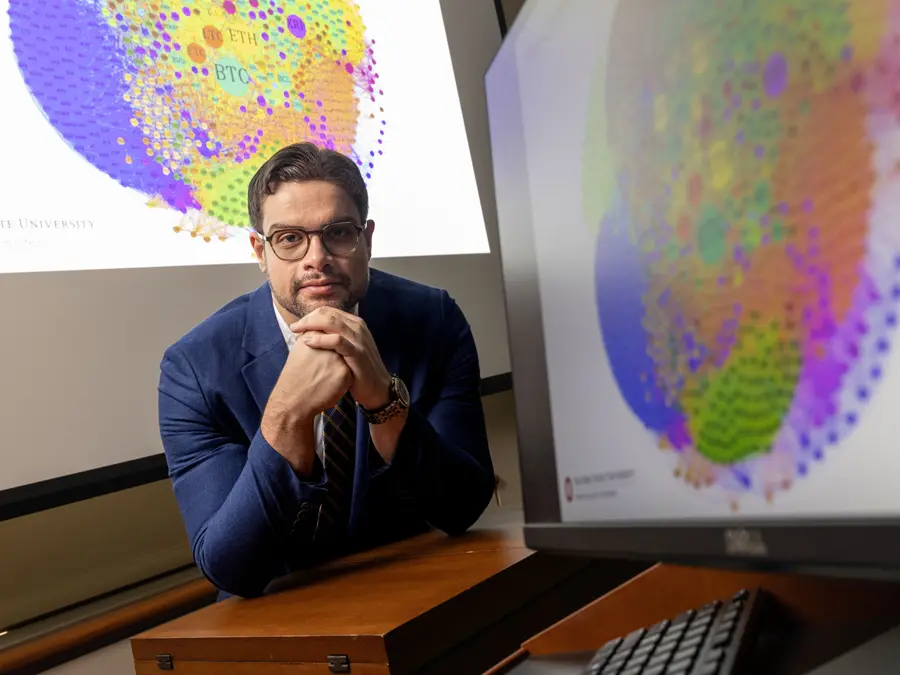Jana Houser, extreme-weather expert, answers 5 questions
Should you stay in your car if there’s a tornado? How does climate change affect weather? She shares the whys and hows.

Associate Professor Jana Houser, who has a PhD in meteorology, specializes in radar analysis of tornadoes and supercell thunderstorms. (Photo illustration by Betsy Becker with images from Jodi Miller, Jana Houser and Getty Images)
No matter where you live, severe weather is a threat. Hurricanes, flooding, winter storms and tornadoes can wreak havoc on our lives.
Associate Professor Jana Houser in the Department of Geography studies severe weather climatology, specifically tornadoes. She also works to understand the effect climate change has on tornadoes and severe weather in Ohio and beyond.
Here, Houser answers alumni questions about those severe weather moments and their destructive ways.
-
Is it safer to stay in your car if you are trapped in a tornado or to get out and lie down in a ditch? — Thomas Brawn ’84
Generally speaking, it is safer to stay in your car because it offers a shell of protection between you and flying debris, which tends to be most dangerous and life-threatening.
The best thing is to try to drive away from the tornado, even if that means driving through hail. Typically, you should drive south, or in whatever direction you see clear sky.
However, if a tornado is bearing down on you, stop the car, turn it off (this disables the airbags), and crouch below the steering wheel to be lower than the bottom of the windows because they are the weak spots.
Do not seek shelter under a bridge or overpass because they create a wind tunnel effect that accelerates air and can suck you out.
Additionally, if you are ever driving and caught in large hail, do not pull under underpasses unless there is ample space on the berm. I have seen countless instances where people do this and block lanes of traffic. This can result in serious car crashes as visibility is severely reduced and drivers approaching do not expect traffic to be stopped.
-
Is there any place in America where we won’t have severe weather of any kind? — Dolores Brannigan ’93
Nope. Everywhere in the U.S. is prone to some sort of extreme weather. But obviously, the type of severe weather varies geographically. Tropical cyclones primarily affect the coastal regions of the eastern and southern U.S. Wildfires, the western half. Snows, the high terrain, the northern U.S. and the Northeast U.S. In terms of tornadoes, the least likely locations are New England, the western interior and the Pacific states. However, every state in the U.S., including Alaska and Hawaii, has had tornadoes.
-
I am curious if the warming of the planet does cause more severe weather. — Christine Metzger Dreps ’87
This is true, but it affects different types of severe weather in different ways. For example, even though we think of a warming planet under climate change, we could actually experience more significant snowstorms, especially along the East Coast. This is because ocean water retains heat much more effectively than air does. So under a warming climate scenario, the oceans will be warmer but the air in winter will still be able to get cold. This will cause a greater temperature difference between land and water, and allow the ocean to more effectively transport moisture into developing winter storms. This will fuel stronger winter storms with greater snowfall potential.
Wildfires and floods will both become more frequent owing to changes in the hydrological cycle where dry conditions create a snowball effect and self-perpetuate, while the great heat availability will also evaporate more moisture, making heavier rains possible.
In terms of thunderstorms and tornadoes, the link is more nebulous because these events are so small-scale that they are often tied to processes and factors that are much smaller than the climate system. However, there is evidence to support that climate change will cause (or is already causing) shifts in the areas that see the greatest frequency of these events. We are likely to see an increase in everyday thunderstorm activity, which is largely driven by heat and moisture processes. The frequency of tornado-producing events may actually go down, but days when we do have tornadoes will be supercharged and produce tornadoes that are potentially more violent.
-
I was taught a long time ago that tornadoes almost always happen before rain and that once it is raining, the risk of a tornado occurring drastically decreases. Is this true? — Dr. Austin Kleman ’14 DVM
Nothing about this statement is true. While there are certainly some instances where this might happen, there are many more where the tornado is so engulfed by rain that you cannot see it coming. While storm chasing, I have been less than 1 mile away from tornadoes you cannot see because of that. Bottom line: Don’t wait for visual confirmation that a tornado is present. Heed warnings and seek shelter if there is a tornado warning.
-
Q: I live in Colorado so tornadoes are fairly small, but we get blizzards and snow events that bring everything to a stop. Do you include winter extreme weather? Is there an interesting coincidence of storm tracking and geology? — David Miller ’78, ’80 MS
A: Yes. By definition, severe weather is any type of weather event that interrupts the everyday experiences of people. This includes droughts, floods, tropical cyclones and winter weather (and of course thunderstorms and tornadoes). Geography plays a huge role in weather events and the overall distribution of what areas of the country receive what types of severe weather most commonly. The atmospheric conditions are intimately tied to the conditions of the land, the availability and distribution of bodies of water, and even mountain ranges.



